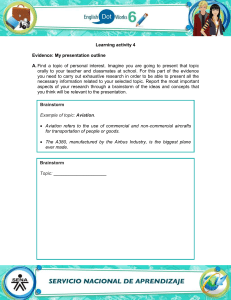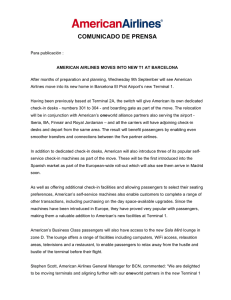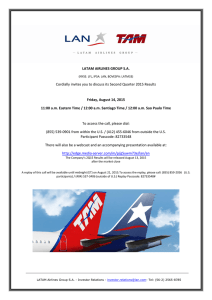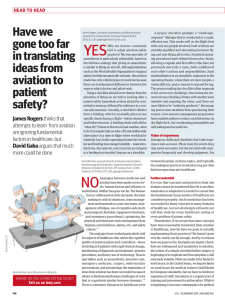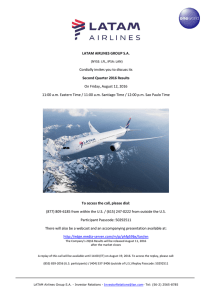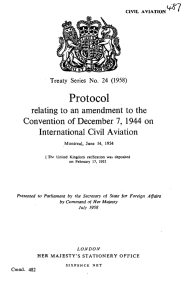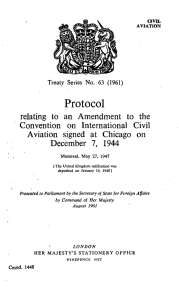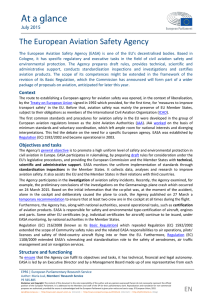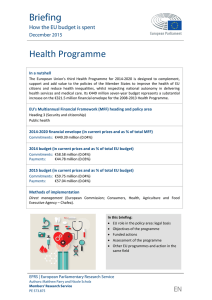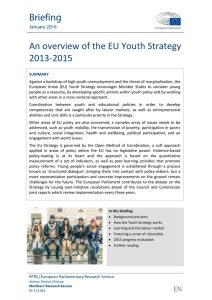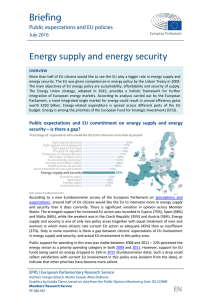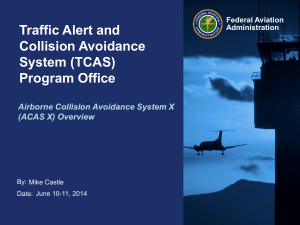Employment and working conditions in EU civil aviation
Anuncio
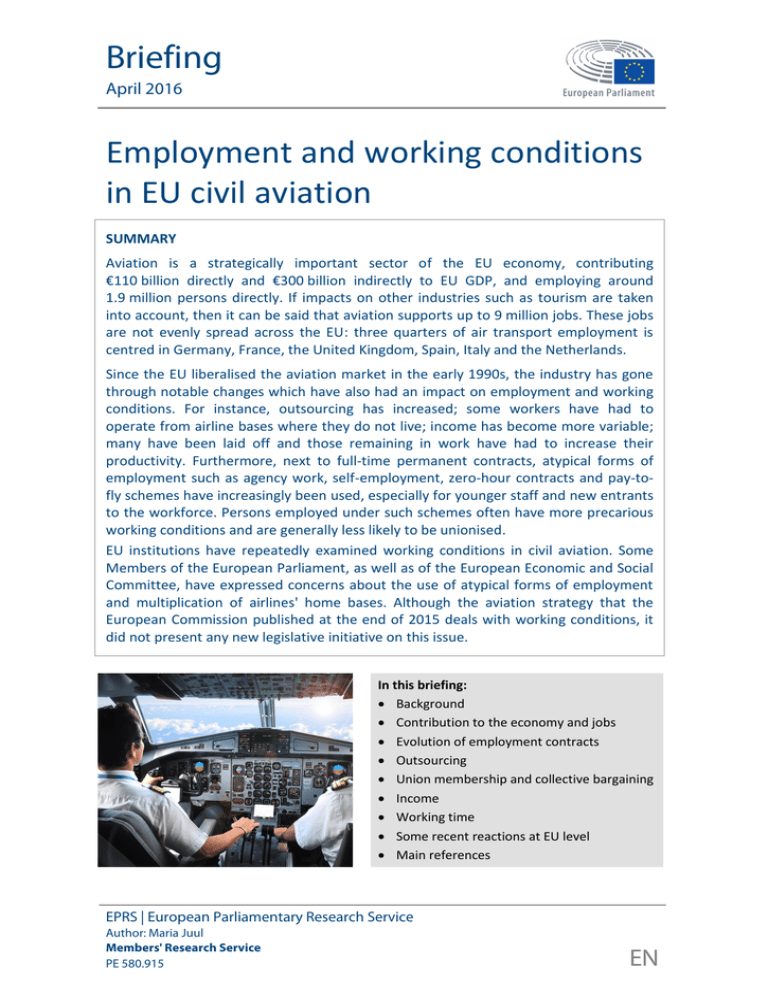
Briefing
April 2016
Employment and working conditions
in EU civil aviation
SUMMARY
Aviation is a strategically important sector of the EU economy, contributing
€110 billion directly and €300 billion indirectly to EU GDP, and employing around
1.9 million persons directly. If impacts on other industries such as tourism are taken
into account, then it can be said that aviation supports up to 9 million jobs. These jobs
are not evenly spread across the EU: three quarters of air transport employment is
centred in Germany, France, the United Kingdom, Spain, Italy and the Netherlands.
Since the EU liberalised the aviation market in the early 1990s, the industry has gone
through notable changes which have also had an impact on employment and working
conditions. For instance, outsourcing has increased; some workers have had to
operate from airline bases where they do not live; income has become more variable;
many have been laid off and those remaining in work have had to increase their
productivity. Furthermore, next to full-time permanent contracts, atypical forms of
employment such as agency work, self-employment, zero-hour contracts and pay-tofly schemes have increasingly been used, especially for younger staff and new entrants
to the workforce. Persons employed under such schemes often have more precarious
working conditions and are generally less likely to be unionised.
EU institutions have repeatedly examined working conditions in civil aviation. Some
Members of the European Parliament, as well as of the European Economic and Social
Committee, have expressed concerns about the use of atypical forms of employment
and multiplication of airlines' home bases. Although the aviation strategy that the
European Commission published at the end of 2015 deals with working conditions, it
did not present any new legislative initiative on this issue.
In this briefing:
Background
Contribution to the economy and jobs
Evolution of employment contracts
Outsourcing
Union membership and collective bargaining
Income
Working time
Some recent reactions at EU level
Main references
EPRS | European Parliamentary Research Service
Author: Maria Juul
Members' Research Service
PE 580.915
EN
EPRS
Employment and working conditions in EU civil aviation
Background
Since the 1990s, the EU has progressively liberalised the aviation market and removed
restrictions for airlines flying within the EU, by allowing them to freely choose routes,
fares and schedules. At the same time, the EU has adopted rules to limit state aid, and
control mergers and the acquisition of shares in EU airlines and airports.
Liberalisation has generally brought benefits to air passengers in the form of greater
accessibility, a diversified offer and somewhat lower air fares. However, liberalisation
has also brought negative developments such as lay-offs, salary reductions and less
favourable employment contracts for many aviation workers. This has led to numerous
strikes in a number of EU Member States, such as France and Germany.
Despite the fact that air passenger traffic in the EU grew approximately 3% a year
between 1995 and 2013, employment levels in aviation have remained stable or
declined in some sub-sectors. This indicates a considerable increase in productivity.
According to consultancy company Steer Davies Gleave's 'Study on employment and
working conditions in air transport and airports',1 productivity increased by 43% over
the 2000-2013 period, if calculated on the basis of EU airline passengers per person
employed, and by 15%, if productivity growth is measured on the basis of persons
employed per flight-kilometre. Productivity is especially high in low-cost airlines. For
example, Irish budget airline Ryanair carried almost 9 000 passengers per employee in
2011, while the former Irish flag carrier Aer Lingus carried just over 2 700 passengers
per employee in the same year.
One of the reasons why aviation companies seek to increase workers' productivity is the
fierce competition from inside the EU but also from third countries such as the Gulf
States or Turkey. Between 1992 and 2015, the number of intra-EU routes served by
more than two airlines went up by more than 540% and extra-EU routes by 300%. Faced
with ever-increasing competition, many EU airlines have adapted their business model
so as to improve cost-effectiveness, for instance, by increasing aircraft utilisation.
Many airlines, in particular low-cost ones, are now operating from multiple bases
('home bases') across the EU, which enables them to return aircraft and crew to the
same base at the end of each day. For example, by April 2016, Ryanair had 83 and
British budget airline EasyJet 26 home bases across the EU.2 This means that persons
employed by the same company are subject to different jurisdictions and conditions,
which can cause legal uncertainties for them and lead to tensions, particularly if they
operate from a base in a country in which they do not live.
At the same time, the distinction between full-service3 and low-cost airlines has become
increasingly blurred. Irrespective of their business model, many airlines now charge for
checked baggage as well as for food and drink on board, and use electronic ticketing
and self-check-in. Low-cost airlines are now also targeting main airports, business
passengers and long-haul routes, which were previously considered the territory of fullservice airlines. In 2015, the share of low-cost airlines reached 48% of seat capacity in
the EU. According to IATA, Ryanair and EasyJet were the world's two biggest airlines in
2014 in terms of the number of scheduled passengers carried on international routes.4
Contribution to the economy and jobs
Aviation is a strategically important sector of the economy which contributes
€110 billion directly and €300 billion indirectly to EU GDP, and employs directly around
1.4-1.9 million5 persons in the EU. Aviation supports 4.8-5.5 million jobs, considering its
Members' Research Service
Page 2 of 10
EPRS
Employment and working conditions in EU civil aviation
indirect and induced impacts along the industry supply chain; this figure could rise to
9.3 million jobs, if aviation's favourable impact on other areas such as tourism or the
EU's attractiveness as a business location is taken into account. A recent analysis has
found that one job created in air transport creates more than three jobs in other
sectors.
There are significant differences in
employment levels between Member
States. In 2013, three quarters of air
transport employment in the EU was
concentrated in six countries:
Germany, France, the UK, Spain, Italy
and the Netherlands (see Figure 1).
There are also differences by gender.
In the same year, 42% of the persons
employed in passenger air transport
were women. At the same time, in
some functions (such as cabin crew)
women are over-represented.
Figure 1 – Direct passenger air transport employment
by EU Member State, 2013
Data source: Commission staff working document, 2015.
Employees and profit margins by sub-sectors
As illustrated in Figure 2, there are significant differences between different types of air
transport service providers in terms of number of employees and profitability.
International network airlines Lufthansa Group, Air-France-KLM and International
Airlines Group together provide about 13 times more jobs than low-cost airlines
Ryanair, EasyJet and Wizz Air. However, the latter make a bigger profit margin and
create many jobs. For example, Ryanair currently employs about 10 000 persons,
compared to 605 persons two decades ago.
A significant amount of employment at airports is created at key hub airport groups:
London Heathrow, Paris, Frankfurt, Aena,6 Amsterdam Schiphol and Munich. Together,
they employ about 3 000 more persons than the other top 100 airport groups together.
Key hub airport groups are almost as profitable as low-cost airlines.
Figure 2 – Number of employees compared to net profit margins in the EU
Data source: Commission staff working document, 2015, p. 31, Chart 13 (compiling various sources from 2013-2014).
Members' Research Service
Page 3 of 10
EPRS
Employment and working conditions in EU civil aviation
On the other hand, smaller airports are struggling to cover their costs. As reported by
the Commission, 77% of EU airports with fewer than 1 million passengers per year were
loss-making in 2014. Small and mid-size network airlines7 were also struggling to make a
profit or had in the meantime gone bankrupt (for instance, Estonian Air). However,
together they still provided more jobs (65 525) than the three aforementioned low-cost
airlines (21 000).
European aircraft producer Airbus is also doing rather well. In 2015, its net income
increased 15% to €2.7 million. The same year it employed overall 136 574 persons. In
2013, European air navigation services providers (ANSPs) employed about
57 500 persons. This is about 40% more than in the United States, where the single
ANSP controls about 57% more flights than various European ANSPs together.
Evolution of employment contracts
In the past, the majority of civil air transport workers were recruited under full-time
permanent contracts with a single employer. Today, more complex forms of
employment ('atypical' employFigure 3 – Pilot-airline employment relationships
ment), such as agency work, selfemployment, zero-hour contracts
and pay-to-fly schemes are
increasingly being used, especially
for younger staff and for those
entering the workforce for the first
time. However, the majority of air
transport workers still have a
direct contract with the employer.
As seen in Figure 3, more than
three quarters of pilots polled for a
Ghent University study8 had a
source: 'Atypical Employment in Aviation', Ghent University,
direct contract with the airline Data
2015.
(87% of the pilots who had a direct
contract with the airline had an open-ended, 13% a fixed-term and 0.3% a stand-by/oncall contract). As seen in Table 1 below, direct contracts are more common in network
and regional airlines and less common in low-cost airlines.
Although temporary agency9
work and self-employment are
Type of airline
% of pilots with a direct legal forms of employment,
employment contract
they may be prone to abuses
that can be detrimental to
Network airline
96.5
workers'
rights
and
fair
Regional airline
92.7
competition.
Some
stakeholders, such as the European
Cargo airline
88.7
Transport Workers' Federation
Charter airline
88.4
(ETF), suggest that these
Business aviation
73.8
contracts
increase
job
precariousness in aviation. ETF
Low-cost airline
52.6
adds that '(J)obs in aviation that
Source: 'Atypical Employment in Aviation', Ghent University, 2015.
used to be prestigious and highquality are disappearing and being outsourced or replaced by cheaper work'. The
Table 1 – Percentage of pilots with a direct employment
contract per type of airline
Members' Research Service
Page 4 of 10
EPRS
Employment and working conditions in EU civil aviation
European Cockpit Association (ECA), which represents pilots, thinks that these contracts
have been forced on pilots.
Usually, a temporary work agency either hires or places, for a fixed term, a limited
company of crew members or individual crew members. However, since in a number of
Member States temping is not subject to explicit time limits, such an assignment can be
concluded for a long time. Low-cost airlines tend to use agency workers across all
functions. Network airlines generally use them for terminal and groundhandling
functions. Some of these workers are hired on lower salaries from outside the EU. ETF
suggests that 'agency workers are far less likely to feel secure or enjoy work-life balance
when compared to directly employed aircrew'. They may have to put in long hours in
summer and go on unpaid leave in winter when passenger numbers are lower. Taking a
summer holiday might be almost impossible for some pilots working through an agency.
Temporary work agencies can also hire self-employed individuals. However, it is not
easy to determine whether this is genuine or bogus self-employment concealing a de
facto employment relationship. EU law does not set any criteria for determining what
constitutes self-employment, leaving it up to Member States to decide whether
someone is self-employed or a disguised employee. For example, under the UK system,
factors pointing towards an employment relationship include personal service provided
solely to one airline, control by the airline over the employee's work, and mutuality of
obligation, whereby the airline obliges to offer and the employee to accept the work
offered. On the other hand, factors indicating a self-employed relationship might for
instance involve working for several airlines, no mutuality of obligation, taking financial
risk, providing own equipment and being able to hire helpers or replacements. Correct
labelling is important not only for tax purposes but also for workers themselves as the
self-employed do not enjoy the same level of legal protection as employees. For example,
self-employed workers do not get paid annual leave. ECA maintains that in reality 'selfemployed' pilots are forced to accept this status, while working for only one airline.
They reportedly have no control over their remuneration, working time or places of work.
Flight crew can also be hired under zero-hour contracts. These contracts (which can be
combined with agency work/self-employment) do not oblige employers to offer or
workers to accept work. Staff working under such contracts are remunerated solely for
the duration of their flights. These contracts do not give rights to paid annual leave,
maternity leave or sick leave.
Some newly graduated pilots are even obliged to contribute financially to the airline in
order to fly ('pay-to-fly') and gain flight experience, despite already often being deeply
indebted due to high flight-school tuition fees. As stated by a pilot in the Ghent
University study, flight schools train too many pilots for too few jobs. That is why some
pilots are willing to start working 'for free with hopes of building up experience and
leave as soon as possible for a better (and paid) job'.
Impact on aviation safety
There is an ongoing debate as to whether atypical forms of employment have an impact
on aviation safety. The Ghent University study suggests that due to more complex
employment relationships, 'adherence to safety regulations is becoming increasingly
precarious'. The same study reports pilots performing duties despite feeling ill,
something that can also raise safety concerns. ECA is of the same view. It believes that
pilots' unstable contractual relationships would ultimately have negative repercussions
for safety, because they might be pressured to prioritise their employers' commercial
Members' Research Service
Page 5 of 10
EPRS
Employment and working conditions in EU civil aviation
needs over safety considerations, and because having to worry about their employment
status would 'distract them from their primary task: flying their passengers safely to
their destination'.
So far, the EU still scores excellent safety results. The fatal accident rate in the EU-28
and the European Free Trade Association has been much lower in the last decade – 1.8
per 10 million flights – than elsewhere: 1.9 in North America, 6.3 in Asia, 15.5 in the
Middle East and 38.3 per 10 million flights in Africa. Low-cost airlines, which are the
biggest users of atypical forms of employment, have not had any major safety accident
with fatalities.
Outsourcing
In order to increase cost efficiency, flexibility and access to resources, airlines, airports
and groundhandlers outsource more and more functions to a second, independent
organisation. The most commonly outsourced functions are specialist functions such as
security, cleaning, groundhandling and administrative roles. However, some airlines also
outsource flight and cabin crew. In other sectors, such as aircraft maintenance and air
navigation services, outsourcing is generally more limited.
Whilst the exact impact of outsourcing on employees' working conditions is not always
clear, stakeholders generally agree that social security is lower for employees working in
outsourced functions. Workers' representatives suggest that outsourced staff receive
lower wages, training and holiday entitlement. They also report increases of fixed-term
contracts and temporary agency employment in outsourced functions.
Union membership and collective bargaining
Collective bargaining agreements10 are common in the air transport sector. They can be
conducted at national, regional, industry or company level, depending on the issue at
hand. The approach to collective agreements varies across the sector and Member
States. In most countries, these agreements apply only to the contracting parties.
Whether they also cover agency workers, part-time and fixed-term staff differs from
one country and agreement to another.
In 2000, the EU created a Civil Aviation Social Dialogue Committee to encourage social
dialogue and improve employment and working conditions in the sector. Currently, the
committee covers air crew, groundhandling and air traffic management, and is
composed of various employers' and workers' representatives (such as the Association
of European Airlines (AEA), the European Cockpit Association (ECA) and the European
Transport Workers' Federation (ETF)). It discusses issues such as training, working time,
and health and safety at work. For instance, in 2011, it adopted a joint statement on the
role of European social dialogue in the implementation of the Single European Sky.
The level of unionisation varies across the sector and Member States. The latter have
different rules and restrictions on union activity as well as forms of protection for union
members. In some countries, such as Belgium, union membership is automatic, while in
others, such as the United Kingdom, it is not. In most Member States different trade
unions represent cabin crew, flight crew, ground operators, administrative staff and
manual staff. Some Member States do not have a dedicated employers' organisation for
the airline industry, in which case their airlines may belong to a general transport
employers' organisation. In addition, some airlines (such as Ryanair) bargain directly
with trade unions.
Members' Research Service
Page 6 of 10
EPRS
Employment and working conditions in EU civil aviation
The perception of unionisation differs among the various stakeholders. While the
majority of airlines which responded to the Steer Davies Gleave study estimated that
91-100% of flight crew were members of a union in 2014, ETF estimated this proportion
to be 41-50%. The picture of unionisation for groundhandling and terminal staff is
mixed, but in general, they are considered to have lower levels of unionisation, which
also holds true for atypically employed staff. The majority of stakeholders did not know
or had differing opinions regarding whether levels of unionisation in the sector have
changed in the past decade.
Income
Persons employed in air transport
generally earn more than other
workers in the transport sector or in
support activities for transport (see
Figure 4). Some 61% of persons
employed in air transport earned
more than €18 000 per year in 2010,
compared to 39% of those employed
in transport and 49% in support
activities for transport.
Figure 4 - Income in air transport compared to other
sectors, EU-28, 2010
The Steer Davies Gleaves study
reports the European Regional
Airlines Association (ERAA) as saying
that the average annual basic salary Data source: Steer Davies Gleave analysis, 2015.
(including allowances) for cabin crew
has decreased by 14% since 2005 and is currently €26 970. In comparison, the same
organisation estimated that the average annual basic salary (including allowances) for
training captains is €89 928, for line captains €78 752 and for co-pilots €49 323.
However, this study also reveals that there is no general agreement among air transport
stakeholders about income trends since 2005. Whilst airlines and airports generally
suggest that incomes have increased either in line with or above inflation, worker
representatives claim they have decreased in real terms. This is partly explainable by
the fact that worker representatives comment for all employees, including those in
outsourced functions or employed by temporary agencies, and airlines and airports only
for those employed within their organisation. Employees in outsourced functions or
employed by temporary agencies tend to earn less. In the same study, ECA suggests
that junior pilots (under 29-years-old) have in particular seen their salaries frozen or
reduced. Employers' representative Airports Council International observes that wages
have also decreased for groundhandling and terminal staff, and the Ghent University
study suggests that budget airlines have developed strategies geared towards lowering
wages. It also reports a trend towards more variable wages.
Working time
Air transport employees frequently have irregular working hours and may be subject to
long work days, irregular sleep, early starts and night duties. Pilots and flight crew also
have to cope with long absences from home. A 2012 barometer11 revealed that the
majority of pilots have experienced fatigue while on duty and a third have fallen asleep
and/or dozed off in the cockpit without agreeing this beforehand with their colleague
Members' Research Service
Page 7 of 10
EPRS
Employment and working conditions in EU civil aviation
(see Figure 5). Many of them (for
Figure 5 - Pilots experiencing fatigue and sleep during
instance, 80-90% of Danish pilots) flight
admitted having made mistakes due
to fatigue. Yet, fearing sanctions or
stigmatisation by the employer or
colleagues, 70-80% of fatigued pilots
would not report it. In exceptional
cases, a short nap with the other
pilot's agreement can be allowed.
However, the examples mentioned in
the
barometer
occurred
unintentionally or without prior
agreement with the other pilot. Data source: European Cockpit Association Barometer, 2012.
Fatigue has already been cited as a
factor in several incidents: for instance, in May 2012 when an Air Berlin plane requested
an expedited landing in Munich. The plane landed safely.
The EU has set flight and rest rules in Regulation No 83/2014, which entered into force
in early 2016. Its Annex II sets out flight and duty limits per day, week, month and year,
in addition to minimum rest per day and month depending on previous duties. It states
for instance, that total flight time should not exceed 1 000 hours per year and total duty
time 60 hours in any seven consecutive days. Due to unforeseen circumstances during
actual flight operation, these limits may be modified under certain conditions.
Working time in air transport is also regulated in general regulations and directives,
such as Directive 2003/88/EC on certain aspects of the organisation of working time.
According to this Directive, workers have a right to a daily rest of 11 consecutive hours
per 24-hour period, to a 24-hour weekly rest as well as to at least four weeks of annual
leave. Night workers must not perform heavy or dangerous work for longer than eight
hours in any 24-hour period. The Commission is currently reviewing the Directive.
Some recent reactions at EU level
European Commission
In its aviation strategy, published in December 2015, the Commission recalls the need to
reinforce the social agenda and create high quality jobs in aviation. It intends to support
social dialogue and strengthen, together with Member States, the analysis of
employment and working conditions in aviation. It will publish a practice guide on
applicable labour law and competent courts, and considers the need to clarify issues
related to employment contracts of mobile workers in aviation. It also intends to raise
these issues when negotiating air transport agreements with third countries. It did not,
however, announce any legislative initiative to improve or modify employment and
working conditions in aviation.
The Commission highlighted the importance of social dialogue and working conditions
at a conference on the 'Social Agenda for Transport' in June 2015. Transport
Commissioner Violeta Bulc underlined the importance of keeping transport an attractive
sector for workers as well as young people. She recognised that 'social dumping has
become a critical issue', while noting that, due to legal constraints, only some issues can
be dealt with under EU law. She expressed the belief that the key way forward was to
improve the enforcement of existing laws.
Members' Research Service
Page 8 of 10
EPRS
Employment and working conditions in EU civil aviation
European Parliament
The European Parliament has paid close attention to employment and working
conditions in air transport in regular meetings as well as in special events, such as those
of 26 March and 7 May 2015, when stakeholders and the authors of the Ghent
University study respectively attended Transport and Tourism (TRAN) and Employment
and Social Affairs (EMPL) Committee meetings.
Flight and rest rules have also been widely debated in the Parliament, for instance at
the time when the Commission adopted Regulation No 83/2014 via the comitology
procedure, requiring the Parliament to take a stance on it before it enters into force.
TRAN had suggested rejecting the act; Parliament backed it with a majority vote in
plenary, although some Members would have preferred to see tougher limits imposed,
and considered the act better suited for airlines and less for pilots and passenger safety.
In a resolution adopted in November 2015, the Parliament stated that certain working
conditions in the aviation sector may have an impact on flight safety. It noted the need
to 'clarify the situation of aircrew that have multiple home bases' and recommended
the Commission study the application of EU rules on temporary agency work. The
Parliament also expressed concern about 'the use of atypical forms of employment such
as bogus self-employment, pay-to-fly schemes and zero-hours contracts'.
Currently, EMPL is drafting a report on social dumping in the EU, and TRAN has been
asked to give its opinion on the same phenomenon with a focus on the transport sector.
In its opinion adopted on 8 April (drafted by Jens Nilsson, S&D, Sweden), it highlighted
the need for the Commission and Member States to implement relevant social law
whilst respecting fair competition and free movement. It also recommended
combatting illegal activities, letterbox companies and unfair business practices such as
atypical contracts, to ensure social protection.
European Economic and Social Committee
In September 2015, the European Economic and Social Committee adopted an owninitiative opinion on 'Social dumping in the European civil aviation sector' in which it
calls upon EU institutions as well as the European Aviation Safety Agency to monitor the
new employment practices. In particular, it suggests that the Commission scrutinise the
application of the Directive on temporary agency work, and advises against the
widespread use of temporary agency contracts. It also advocates the introduction of a
common definition for 'employed person' and 'self-employed person'. It further
deplores that some third-country airlines operating flights into the EU still use practices
that are in breach of EU legislation, such as dismissal for pregnancy. It also regrets the
use of non-EU crew with inferior working conditions and salaries on board EU-registered
aeroplanes.
Main references
'Study on employment and working conditions in air transport and airports', Steer Davies Gleave
for the European Commission, 2015.
'Atypical Employment in Aviation', University of Ghent, 2015.
Endnotes
1
The study was prepared for the Commission in 2015. It is an update and extension of a previous study by Steer
Davies Gleave on the same topic. It covers the full scope of air transport and related industries in the EU.
2
These data are changing quickly as low-cost airlines keep opening and closing bases to respond to fluctuations in
demand or other factors (such as airport charges).
Members' Research Service
Page 9 of 10
EPRS
Employment and working conditions in EU civil aviation
3
Also called network, flag or legacy carrier/airline.
4
When domestic routes are also taken into account, the world's biggest airline in terms of scheduled passengers
carried in 2014 was Delta Air Lines.
5
Of which 400 000 are established within the airport perimeter.
6
A state-owned company managing general-interest airports and heliports in Spain.
7
TAP, LOT, SAS, Finnair, Czech Airlines, Aegean Airlines, Alitalia, Air Berlin, Adria Airways, Croatia Airlines, Flybe, Air
Baltic, Estonian Air, Aer Lingus, Air Europa and Brussels Airlines.
8
The study was produced with the financial support of the Commission and concentrates on pilots. It includes a
survey of 6 633 pilots (the highest number of respondents were from Ryanair, Air France, KLM and SAS).
9
Defined in EU Directive 2008/104/EC as 'any natural or legal person who, in compliance with national law,
concludes contracts of employment or employment relationships with temporary agency workers in order to
assign them to user undertakings to work there temporarily under their supervision and direction'.
10
Agreements that are negotiated between an employer or employers' association and a trade union or employee
representative body.
11
The barometer brings together several surveys where ECA member associations asked more than 6 000 European
pilots to self-assess their level of fatigue.
Disclaimer and Copyright
The content of this document is the sole responsibility of the author and any opinions expressed therein
do not necessarily represent the official position of the European Parliament. It is addressed to the
Members and staff of the EP for their parliamentary work. Reproduction and translation for noncommercial purposes are authorised, provided the source is acknowledged and the European Parliament is
given prior notice and sent a copy.
© European Union, 2016.
Photo credits: © pixel974 / Fotolia.
[email protected]
http://www.eprs.ep.parl.union.eu (intranet)
http://www.europarl.europa.eu/thinktank (internet)
http://epthinktank.eu (blog)
Members' Research Service
Page 10 of 10
